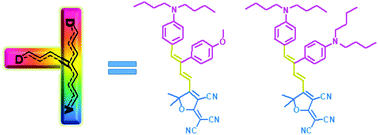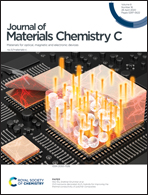The synthesis of second-order nonlinear optical chromophores with conjugated steric hindrance for electro-optics at 850 nm†
Abstract
Electro-optic materials at the shortwave infrared window (850 nm) is significant for optical modulation in free-space communication and short-distance local area networks. However, most of the current high-performance organic nonlinear optical chromophores (absorption bandgap ∼1.5 eV) are designed for operating at 1310 nm (O band) or 1550 nm (C band) and do not exhibit optical transparency at 850 nm (bandgap ∼1.45 eV). The design and synthesis of chromophores exhibiting optical transparency at 850 nm are more challenging because regular bandgap engineering to improve microcroscopic nonlinearity (μβ value) might not be available due to the bandgap restriction (optical transparency) at 850 nm. In this respect, this manuscript utilizes the strategy of suitable site-isolation in molecular engineering to optimize the comprehensive performance of chromophores for electro-optics at 850 nm. Vilsmeier formylation has been facilitated on symmetric or asymmetric donor–π–donor intermediate dyes to form donor–π–acceptor (D–π–A) chromophores C1 and C2 with tunable conjugated steric hindrance (a site-isolator). Without significant red-shifts in the absorption spectra, conjugated steric hindrance groups contribute to large enhancement in the μβ values of the chromophores and ensure optical transparency at 850 nm. The μβ values of C1 (6706 × 10−48 esu) and C2 (7279 × 10−48 esu) with conjugated site-isolation groups are much higher than that of previously reported chromophores at 850 nm. The structure–property relationship reveals that a suitable site-isolator is extremely significant for realizing highly efficient translation of microscopic hyperpolarizability into macroscopic electro-optic coefficients. As a result, an electro-optic coefficient of 94 pm V−1 at 830 nm was achieved. To the best of our knowledge, this is the highest value for organic electro-optic materials at 850 nm.



 Please wait while we load your content...
Please wait while we load your content...